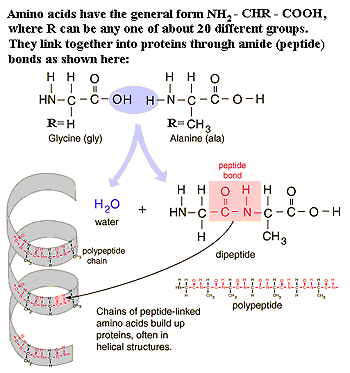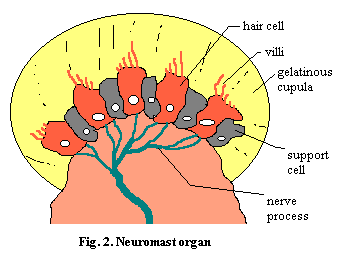| Glossary | ||
| The Vertebrates | N |
| Vertebrates Home | Vertebrate | Vertebrate | Bones | Time |
For most phrases beginning with directional words, e.g. "posterior," "dorsal," "external," etc., or some generic anatomical terms, e.g., "vena," look under the next word in the phrase. However, note that this convention is not used with complete consistency in this Glossary.

N-terminal when amino acids are linked to form proteins, the amino group (-NH2) of one amino acid combines with the carboxyl group (-COOH) of the next to form an amide or peptide linkage (-CONH-) as shown in the image. This leaves a free amino group at one end of the protein and a carboxyl group at the other. The end of the protein with the free amino group is called the N-terminal or amino-terminal region. The end with the free carboxyl group is called the C-terminal or carboxy-terminal region.
Namurian European Carboniferous epoch, normally subdivided into three stages, A - C. Namurian A is roughly equivalent to The Serpukhovian Epoch of the Early Carboniferous. Namurian B & C together correspond to the first half of the Bashkirian Epoch of the Late Carboniferous. The Namurian thus relates to the period from about 333 to 316 Mya.
Nares L. naris = nostril.
Narial relating to the nose.
Naso-frontal hinge the medial articulation of a bird's upper beak with the skull. The articulation permits the upper jaw to swing upward relative to the skull and increases the possible gape. In some neornithine species with long beaks, the upper beak can be moved significantly without opening the jaws at all.
Navicular [1] One of the distal tarsals. It normally articulates proximally with the astragalus and distally with one or more of the cuneiforms. See figure at Protocetidae. [2] shaped like a boat. [3] the distal sesamoid in ungulates.
Nektonic habitually swimming
Neochoanate palatal foramen for Jacobson's organ separate from choana.
Neotype The single specimen designated as the name-bearing type of a nominal species or subspecies for which no holotype, or lectotype, or syntype(s), or prior neotype, is believed to exist.
Nemegt Formation Late Cretaceous of Mongolia, probably Early Maastrichtian, ~70 Mya, with the base in the late Campanian. Teviornis Kurochkin et al. (2002).
Neritic the neritic zone includes all marine waters out to the point at which the continental shelf begins to drop off rapidly, or, by convention, to a depth of 300 m.
Neuquén Basin Northwestern Argentina. A large, presently arid region of Late Triassic to Paleocene sediments. The Neuquen sediments are divided into three supercycles: Jurassic (Late Triassic and Early Jurassic), Ándico (Early Jurassic to Early Cretaceous), and Riográndico (Late Cretaceous to Paleocene). Salgado et al. (2005). The Riograndico is divided into two cycles. The Neuqueniano or Neuquen Group consists of river sediments in a continental setting from the High Cretaceous and earlier Campanian. The Malalhueyano or Malargüe Group consists of marine sediments from the advancing South Atlantic (End Cretaceous and Paleocene), during which time the eastern part of the Basin became a foreland basin, filling with molasse from the mountains in the West. Id.
Neuquén Formation See Río Neuquén Formation.
Neural arch any of the dorsal arches of the spine. The neural arches may have been the first bone elements to evolve on the spine. They probably acted to enclose and protect he dorsal nerve which rested on the notochord. Originally, there were two arches per embryonic segment, a neural and an interneural arch, q.v. for details.
Neural crest see Early Development Terms.
Neural foldsee Early Development Terms.
Neural plate see Early Development Terms.
Neurapophysisthe structure forming either side of the neural arch; but may also be used to refer to the dorsal process of the neural arch, i.e. a neural spine or spinous process.

Neurocentral suture term used in developmental biology and anatomy, with somewhat different connotations. The term refers simply to a suture between the vertebral body (centrum) and the neural arch above it. Usually, the implication is that the organism is young or pedomorphic, with the (usually unstated) assumption that the normal state is fusion of centrum and neural arch. In the anatomy of non-tetrapod vertebrates, the "normal" state is not necessarily fusion, so the presence of a suture merely represents one position in a continuum of relationships between centrum and arch, without any developmental baggage. Just to confuse matters, Huxley 1859), who ought to know since he invented the term, argues that the neurocentral suture doesn't necessarily represent the developmental boundary between centrum and arch.
Neuromast organThe basic unit of mechanoreception (current, balance and hearing) consisting of hair cells and support cells embedded in a gelatinous cupula. Mechanical deformation of the villi on the hair cells alters the signal transmitted to the brain by the nerve processes which synapse with the hair cells. See entry on hair cells for slightly) fuller explanation.
Neurulation see Early Development Terms.
New Haven Formation Late Triassic (Carnian & Norian) of North America (Connecticut, USA), Newark Supergroup. Several different Crurotarsi. Olsen et al. (2000).
Newark Supergroup "The early Mesozoic Newark Supergroup comprises the remnants of the sedimentary and igneous fill of a long series of fault-bounded basins that formed in continental crust along the eastern margin of North America in response to extensional forces during the initial phase of the breakup of Laurasia." Sues 1992: 142).

Nocona Formationformerly, the Admiral Formation; Wichita Group. Possibly Asselian but more likely late Sakmarian of Texas. Overlies Archer City Formation and underlies the Petrolia Formation. Plants rare. Mudstone, sandstone, siltstone, and conglomerates. Sandstone in broad channel-fillbodies, tan to dark-reddish-brown, fine-grained to very coarse grained. See Sherman Sheet. Probably a floodplain drainage system. Labandeira & Allen (2007).
NotariumIn birds and pterosaurs, a series of fused dorsal vertebrae separate from, and anterior to, the sacrum (or synsacrum) which stiffens the body, improving energy efficiency in flight. Strictly speaking, the term is Latin for a secretary of indeterminate gender. However, it seems unlikely that pterosaurs, for example, needed much clerical help.
Notochord a continuous dorsal rod of cartilaginous material running from the head to the tail. This is perhaps the "defining" characteristic of the chordates. In more derived forms, the notochord is excluded from the head and may become discontinuous, its structural function assumed by serial ossifications, i.e. the vertebrae.
Notochordal pit used somewhat inconsistently, but usually refers to the cavity which receives the convex anterior end of the notochord in the braincase.
Nuchal relating to the neck. nucha = the back of the neck. This word, originally Arabic (nuq?), was adopted into Latin and changed in French to nuque.
Nuchal crest a transversely oriented crest at the back of the skull table.
Nuchal gap the gap between the cranial and thoracic armor of placoderms.
Nutritive foramina peculiar foramina in the vertebral centra found only in the Plesiosauria.
checked ATW030614